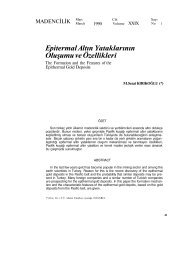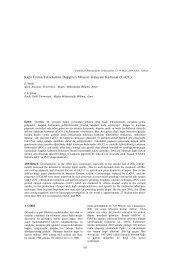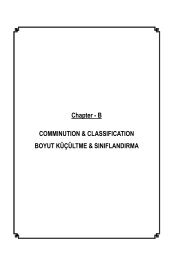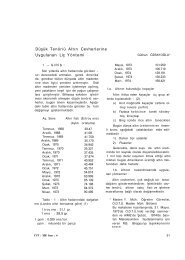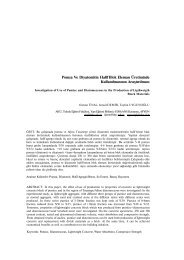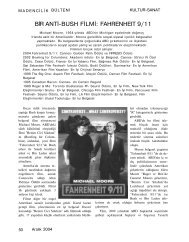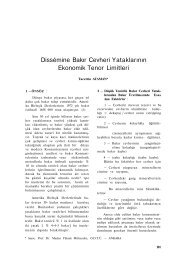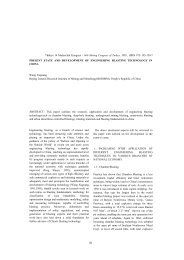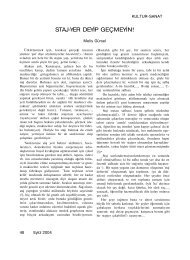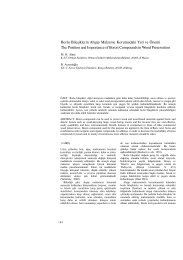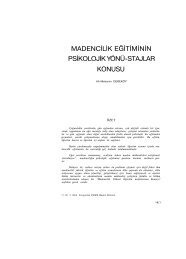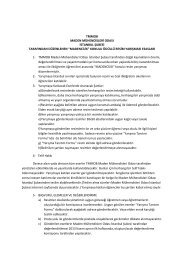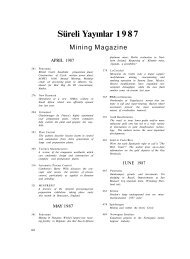A OPEN PIT MINING AÇIK OCAK MADENCİLİĞİ
A OPEN PIT MINING AÇIK OCAK MADENCİLİĞİ
A OPEN PIT MINING AÇIK OCAK MADENCİLİĞİ
Create successful ePaper yourself
Turn your PDF publications into a flip-book with our unique Google optimized e-Paper software.
23 rd <br />
Environment<br />
Economy<br />
Society<br />
Sustainable<br />
mining<br />
Figure 1- Principles of sustainable mining<br />
(Osanloo, 2012)<br />
They listed six recommendations that if<br />
followed, “would help any mine improve the<br />
sustainability of its industrial practices”:<br />
1) Improved planning, 2) improved<br />
environmental management, 3) cleaner<br />
technology implementation, 4) increased<br />
stakeholder involvement, 5) formation of<br />
partnerships, and 6) improved training.<br />
According to mentioned viewpoints, one<br />
aspect of mining activity is the sustainable<br />
development and should be considered in<br />
mine design to keep balance among<br />
economy, environment and society.<br />
3 MINE HAULAGE SYSTEMS<br />
All mines require efficient equipment to<br />
move material in a cost and time effective<br />
manner. As shown in figure 2, the haulage<br />
cost is very significant in mining operation.<br />
Prior to World War II, rail haulage was the<br />
principal type of transportation in large pits.<br />
Now, in most surface mines, the bulk of the<br />
mined material is transported from the mine<br />
to the crusher by trucks (Hoppe, 1977).<br />
Figure 3 shows a block flow diagram of<br />
truck and shovel operation.<br />
Over the past decades mining equipment<br />
have steadily increased in size and<br />
complexity. For instance, the 400-tonne<br />
trucks of today are about 10 times the size of<br />
the 35-tonne trucks of the 1950s. For every<br />
10 years during this period, there has been a<br />
50% increase in truck payload (Koehler,<br />
2003).<br />
Figure 2- Typical open pit mining costs by<br />
activity (Gregory, 2003)<br />
Figure 3- Block flow diagram of truck and<br />
shovel operation<br />
In hard rock mines, truck and shovel<br />
operation is still the most prevalent mining<br />
method.<br />
Since the 1940s, continuous mining and<br />
haulage with bucket wheel excavators and<br />
conveyors has been the predominant method<br />
for high capacity coal or lignite production<br />
and overburden removal in open pit softrock<br />
mining.<br />
The bucket wheel excavator is favorable<br />
connected to a belt conveyor system with or<br />
without a mobile transfer conveyor<br />
intermediately installed or a cross pit<br />
spreader transferring the material to the<br />
waste dump or the raw material stockpile.<br />
In 1956, the first in-pit crusher (IPC) was<br />
installed in a limestone quarry in Hover,<br />
West Germany. The crusher enabled the<br />
quarry operator to take advantage of<br />
continuous belt conveyor haulage and<br />
eliminated a problem of high-cost road<br />
construction and maintenance in wet soft<br />
ground, with resultant cost savings.<br />
In-pit crusher systems have mobility<br />
capabilities that range from fully mobile<br />
units in continuous use to permanently fixed<br />
units. Figure 4 show the material flow in<br />
open pit mine based on in-pit crusher type.<br />
131



